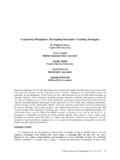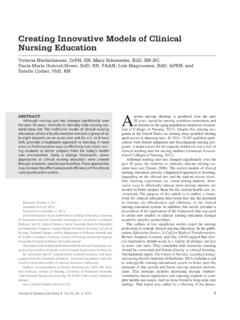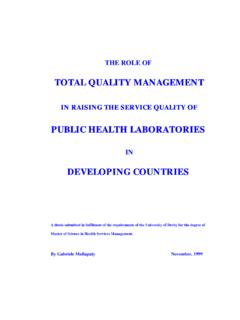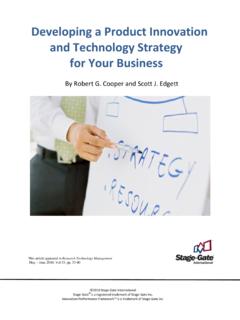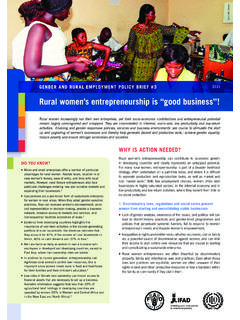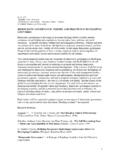Transcription of comparison of mission statements and their rationales in ...
1 64 Int. J. Technology Management, Vol. 16, Nos. 11213, 1998. A comparison of mission statements and their rationales in innovative and non-innovativefirms Christopher K. Bart Michael G. DeGroote School of Business, McMaster University, Hamilton, Ontario, Canada, L8S-4M4. Abstract: This article presents findings from research which examiped and analyzed the content of mission statements from 72 North American corporations. Specifically, 25 mission statement components were analysed to determine if there were any differences between innovative and non- innovative organizations. In addition, the rationales behind the creation of the mission statements in both types of firms were also examined and compared.
2 The findings suggest that there are some mission components and rationales which seem to vary significantly between innovative and non- innovative companies and it is these to which managers should pay especially close attention. Keywords: mission statement; strategy; innovation; purpose; vision; content. Reference to this paper should be made as follows: Bart, (1998) 'A. comparison of mission statements and their rationales in innovative and non- innovative firms'. Inr. J. Technology Management, Vol. 16, Nos. 1/2/3. Biographical notes: Christopher K. Bart is Canada's leading researcher on organizational mission and vision statements .
3 He is currently Professor of Business Strategy at the Michael G. DeGroote School of Business (McMaster University. Hamilton. Ontario Canada, US-4M4) and is the founding Director of the Management of Innovation and New Technology Research Centre Dr. Bart's research focuses on understanding those management practices which help firms maintain and improve their effectiveness. 1 Introduction mission statements are everywhere these days. So much so that Bain and Company has recently declared them the most popular instrument ever deployed by senior managers in the last ten years [I].But, surprisingly, the amount of information available on mission statements is relatively sparse.
4 Much of the historical literature is simply filled with content analyses performed on various samples of mission statements [2,3,4]. Only recently has there been any attempt to better understand the specific circumstances under which mission statements are effectively deployed [5, ,8,9,10]. But much remains to be done. One interesting question which has not been previously considered concerns the differences in mission statements which might exist between innovative and non- innovative organizations. Copyright Q 1998 Inderscience Enterprises Ltd. A comparison of mission statements and their rationales 65. Why mission statements should vary withjrm innovativeness Over the years, there has been a growing recognition of the need for executives to manage dissimilar business situations differentially.
5 Not all organizational circumstances are the same and therefore the managerial responses required should be tailored to fit the specific context. This approach is often referred to as organizational contingency theory and has been applied to the case of innovative organizations by Galbraith and Kazanjian as follows: "For the innovating organization, what is called for is an absence of formal structure as bureaucracy is anathema to innovation. Rules, regulations, procedures, accepted practice and programmed activity will stifle creativity and drive out new ideas ..What is needed is the organizational climate of an independent start up firm, characterized by an informal, unstructured, group problem solving approach where decisions are made quickly and communications are personal and face to face.
6 ". Thus. innovative corporations require organizational arrangements ( , systems, procedures, approaches, etc.) different from non- innovative ones. What, then, about the mission statements ? Without a doubt, the mission statement is regarded as one of the most fundamental building blocks of an organization. It is both the cornerstone of any firm's strategic planning process [11,12] and is considered the starting point in such hot topics as re- engineering, TQM, and self directed work teams. Given our earlier comments on contingency theory, however, it would seem only natural to expect the nature and content of mission statements to vary significantly between different types of organizations - especially, innovative and non- innovative companies.
7 After all, if innovation is a critical strategic advantage for an organization. it should somehow be reflected in the mission [6]. But, exactly how true is this? Currently, the answer to this question is unknown and this, in turn, is what prompted the basis for the current research project. mission statement rationales : The bottom line In its most basic form, a mission statement is a formal written document intended to capture an organization's unique purpose and practices [6,7,8,10,13,14,15,16,17]. It should answer some fairly fundamental questions such as: 1. Why does this organization exist? 2. Why is this organization here?
8 3. What is this organization trying to accomplish? The traditional major rationales and benefits associated with mission statements have been cited as: a. Better control over the behaviour and actions of employees (resulting from their inspired commitment to achieving the mission );. b. More focused resource allocation; and c. A better balance between the interests of competing stakeholders ( , customers. employees, shareholders and society). Recently, there has been some research which suggests that there may also be specific financial performance advantages associated with selected mission practices [6,8,9,10). Nevertheless, the bulk of the evidence to date indicates that the primary benefits of mission statements are more behavioural -than financial - in nature.]
9 In addition, none of the rationales for having a mission statement in the first place has been specifically investigated in the context of innovative versus non- innovative organizations. To the extent that significant differences exist, these should be identified since the innovation track record of North American and European firms is lacking, and anything which might point to improving their performance would be both highly welcomed and keenly examined. 2 The research questions Given both the importance of mission statements (in terms of their ubiquity) and innovation (for long term economic survival), we decided to address the issue of their linkage and association directly.
10 After all, if we are to continue promoting the use and benefits of mission statements , we need to provide as much guidance as possible on how best to use them. And, no where is this more true than in the case of those organizations seeking to become - or remain - innovative . Consequently, a research project was launched to answer several specific questions: Are there differences in the content and characteristics of mission statements between innovative and non- innovative organizations? Are there differences in the rationales used to create and drive mission statements within innovative (as opposed to non- innovative ) firms?
